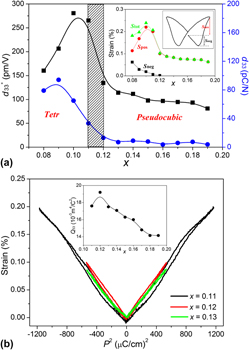Crossref Citations
This article has been cited by the following publications. This list is generated based on data provided by
Crossref.
Hao, Jigong
Shen, Bo
Zhai, Jiwei
Liu, Chunze
Li, Xiaolong
and
Gao, Xingyu
2013.
Switching of morphotropic phase boundary and large strain response in lead-free ternary (Bi0.5Na0.5)TiO3–(K0.5Bi0.5)TiO3–(K0.5Na0.5)NbO3 system.
Journal of Applied Physics,
Vol. 113,
Issue. 11,
Hao, Jigong
Ye, Chenggen
Shen, Bo
and
Zhai, Jiwei
2013.
Enhanced electrostricitive properties and thermal endurance of textured (Bi0.5Na0.5)TiO3–BaTiO3–(K0.5Na0.5)NbO3 ceramics.
Journal of Applied Physics,
Vol. 114,
Issue. 5,
Cheng, Xiaojing
Wu, Jiagang
Wang, Xiaopeng
Zhang, Binyu
Zhu, Jianguo
Xiao, Dingquan
Wang, Xiangjian
Lou, Xiaojie
and
Liang, Wenfeng
2013.
Lead-free piezoelectric ceramics based on (0.97 − x)K0.48Na0.52NbO3-0.03Bi0.5(Na0.7K0.2Li0.1)0.5ZrO3-xB0.5Na0.5TiO3 ternary system.
Journal of Applied Physics,
Vol. 114,
Issue. 12,
Dittmer, Robert
Jo, Wook
Webber, Kyle G.
Jones, Jacob L.
and
Rödel, Jürgen
2014.
Local structure change evidenced by temperature-dependent elastic measurements: Case study on Bi1/2Na1/2TiO3-based lead-free relaxor piezoceramics.
Journal of Applied Physics,
Vol. 115,
Issue. 8,
Li, Fei
Jin, Li
Xu, Zhuo
and
Zhang, Shujun
2014.
Electrostrictive effect in ferroelectrics: An alternative approach to improve piezoelectricity.
Applied Physics Reviews,
Vol. 1,
Issue. 1,
p.
011103.
Hao, Jigong
Xu, Zhijun
Chu, Ruiqing
Li, Wei
and
Du, Juan
2015.
Lead-free electrostrictive (Bi0.5Na0.5)TiO3–(Bi0.5K0.5)TiO3–(K0.5Na0.5)NbO3 ceramics with good thermostability and fatigue-free behavior.
Journal of Materials Science,
Vol. 50,
Issue. 15,
p.
5328.
Zhang, Xiaoli
Wu, Meihua
Diao, Wenxin
Zhang, Bing
Hao, Jigong
Xu, Zhijun
and
Chu, Ruiqing
2015.
Large electrostrictive effect and bright upconversion luminescence in Er-modified 0.92(Bi0.5Na0.5)TiO3–0.08(Ba0.90Ca0.10)(Ti0.92Sn0.08)O3 lead-free ceramics.
Physica B: Condensed Matter,
Vol. 474,
Issue. ,
p.
1.
Hao, Jigong
Xu, Zhijun
Chu, Ruiqing
Li, Wei
Juan, Du
and
Peng, Fu
2015.
Enhanced energy-storage properties of (1− x )[(1− y )(Bi 0.5 Na 0.5 )TiO 3 – y (Bi 0.5 K 0.5 )TiO 3 ]– x (K 0.5 Na 0.5 )NbO 3 lead-free ceramics.
Solid State Communications,
Vol. 204,
Issue. ,
p.
19.
Sayyed, Shahin
Acharya, Smita A.
Kautkar, Pranay
and
Sathe, Vasant
2015.
Structural and dielectric anomalies near the MPB region of Na0.5Bi0.5TiO3–SrTiO3 solid solution.
RSC Advances,
Vol. 5,
Issue. 63,
p.
50644.
Lee, Ji‐Hyun
Kim, Dae‐Hyeon
Seo, In‐Tae
Kim, Jong‐Hyun
Park, Jong‐Seong
Ryu, Jungho
Han, Seung Ho
Jang, Bo‐yun
Nahm, Sahn
and
Damjanovic, D.
2016.
Large Strain in CuO‐added (Na0.2K0.8)NbO3 Ceramic for Use in Piezoelectric Multilayer Actuators.
Journal of the American Ceramic Society,
Vol. 99,
Issue. 3,
p.
938.
Hao, Jigong
Xu, Zhijun
Chu, Ruiqing
Li, Wei
Fu, Peng
Du, Juan
and
Li, Guorong
2016.
Large electrostrictive effect and strong photoluminescence in rare-earth modified lead-free (Bi0.5Na0.5)TiO3-based piezoelectric ceramics.
Scripta Materialia,
Vol. 122,
Issue. ,
p.
10.
Maqbool, Adnan
Hussain, Ali
Rahman, Jamil Ur
Malik, Rizwan Ahmed
Song, Tae Kwon
Kim, Myong-Ho
and
Kim, Won-Jeong
2016.
Composition-dependent structural, dielectric and ferroelectric responses of lead-free Bi0.5Na0.5TiO3-SrZrO3 ceramics.
Journal of the Korean Physical Society,
Vol. 68,
Issue. 12,
p.
1430.
Feng, Qin
Liu, Xiao
Yuan, Changlai
Liu, Xinyu
Zhou, Changrong
and
Chen, Guohua
2016.
Enhanced energy storage properties of Bi0.5Li0.5TiO3 modified Sr0.1Bi0.45Na0.45TiO3 based ceramics.
Journal of Advanced Ceramics,
Vol. 5,
Issue. 3,
p.
219.
Park, Jongseong
Kim, Dae‐Hyeon
Lee, Tae‐Gon
Cho, Sung‐Hoon
Park, Su‐Jin
Ryu, Jungho
and
Nahm, Sahn
2017.
CuO‐added KNbO3‐BaZrO3 lead‐free piezoelectric ceramics with low loss and large electric field‐induced strain.
Journal of the American Ceramic Society,
Vol. 100,
Issue. 7,
p.
2948.
Ahn, Chang Won
Choi, Gangho
Kim, Ill Won
Lee, Jae-Shin
Wang, Ke
Hwang, Younghun
and
Jo, Wook
2017.
Forced electrostriction by constraining polarization switching enhances the electromechanical strain properties of incipient piezoceramics.
NPG Asia Materials,
Vol. 9,
Issue. 1,
p.
e346.
Ullah, Aman
Gul, Hafiza Bushra
Ullah, Amir
Sheeraz, Muhammad
Bae, Jong-Seong
Jo, Wook
Ahn, Chang Won
Kim, Ill Won
and
Kim, Tae Heon
2018.
Giant room-temperature electrostrictive coefficients in lead-free relaxor ferroelectric ceramics by compositional tuning.
APL Materials,
Vol. 6,
Issue. 1,
Lu, Xu
Wang, Liang
Jin, Li
Hu, Qingyuan
Tian, Ye
Hou, Lei
Yu, Kun
Zhang, Lin
Wei, Xiaoyong
Yan, Yan
and
Liu, Gang
2018.
Ultra-low hysteresis electrostrictive strain with high thermal stability in Bi(Li0.5Nb0.5)O3-modified BaTiO3 lead-free ferroelectrics.
Journal of Alloys and Compounds,
Vol. 753,
Issue. ,
p.
558.
Lu, Xu
Hou, Lei
Jin, Li
Wang, Dawei
Hu, Qingyuan
Alikin, D.O.
Turygin, A.P.
Wang, Liang
Zhang, Lin
and
Wei, Xiaoyong
2018.
Origin of composition-insensitive electrostrictive coefficient and continuous decrease of domain wall density in (1-x)NaNbO3-xBaTiO3 lead-free ferroelectrics.
Journal of the European Ceramic Society,
Vol. 38,
Issue. 9,
p.
3127.
Pradhan, Lagen Kumar
Pandey, Rabichandra
Kumar, Sunil
Supriya, Sweety
and
Kar, Manoranjan
2018.
Octahedral distortion due to oxygen vacancy reduction in La3+ modified BNT-BTO solid solutions near morphotropic phase boundary.
Journal of Physics D: Applied Physics,
Vol. 51,
Issue. 37,
p.
375301.
Pradhan, Lagen Kumar
Pandey, Rabichandra
Kumar, Sunil
Supriya, Sweety
and
Kar, Manoranjan
2018.
Role of lattice distortion on diffuse phase transition temperatures in Bi0.5Na0.5TiO3-BaTiO3 [BNBTO] solid solutions.
Vol. 1942,
Issue. ,
p.
030018.
